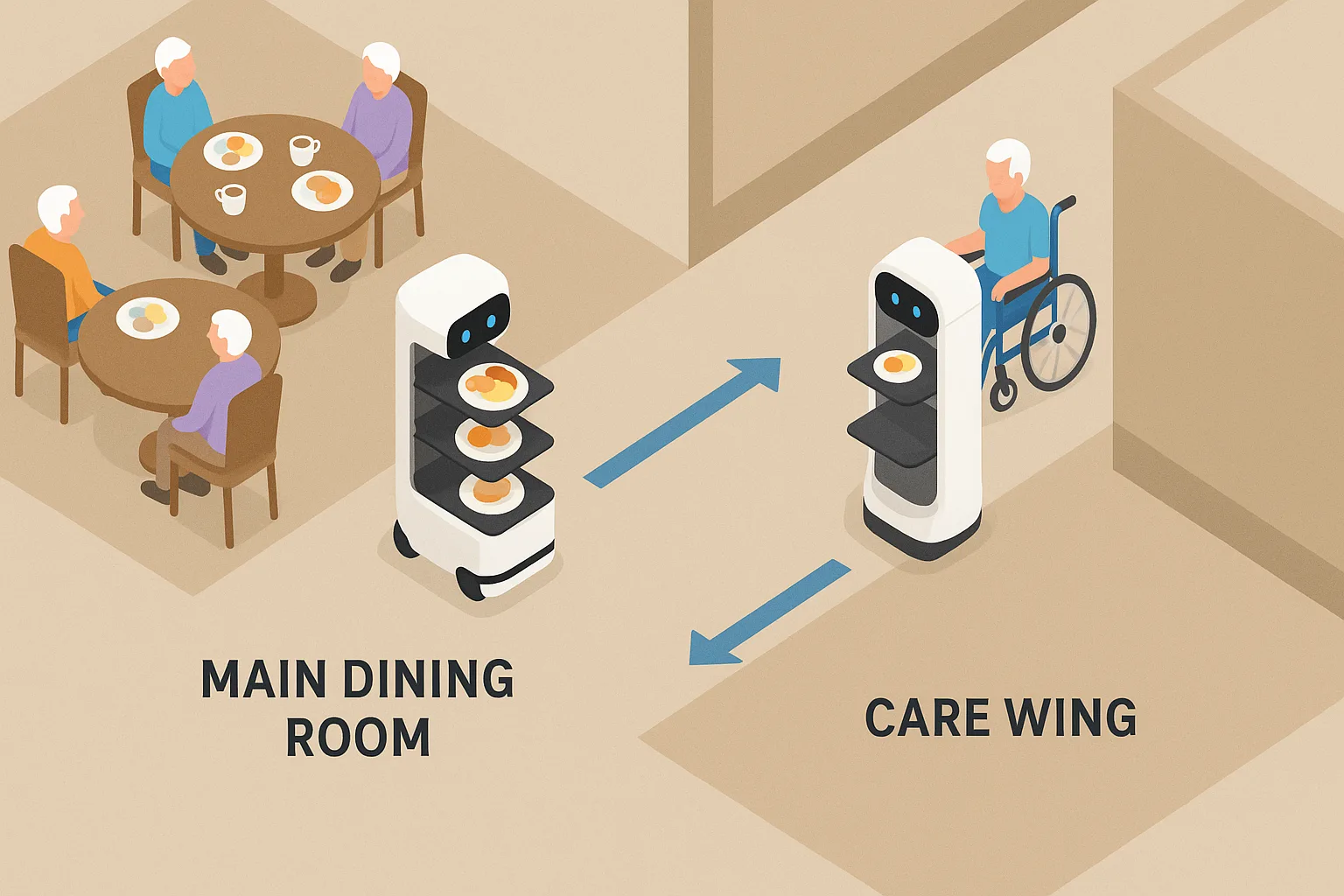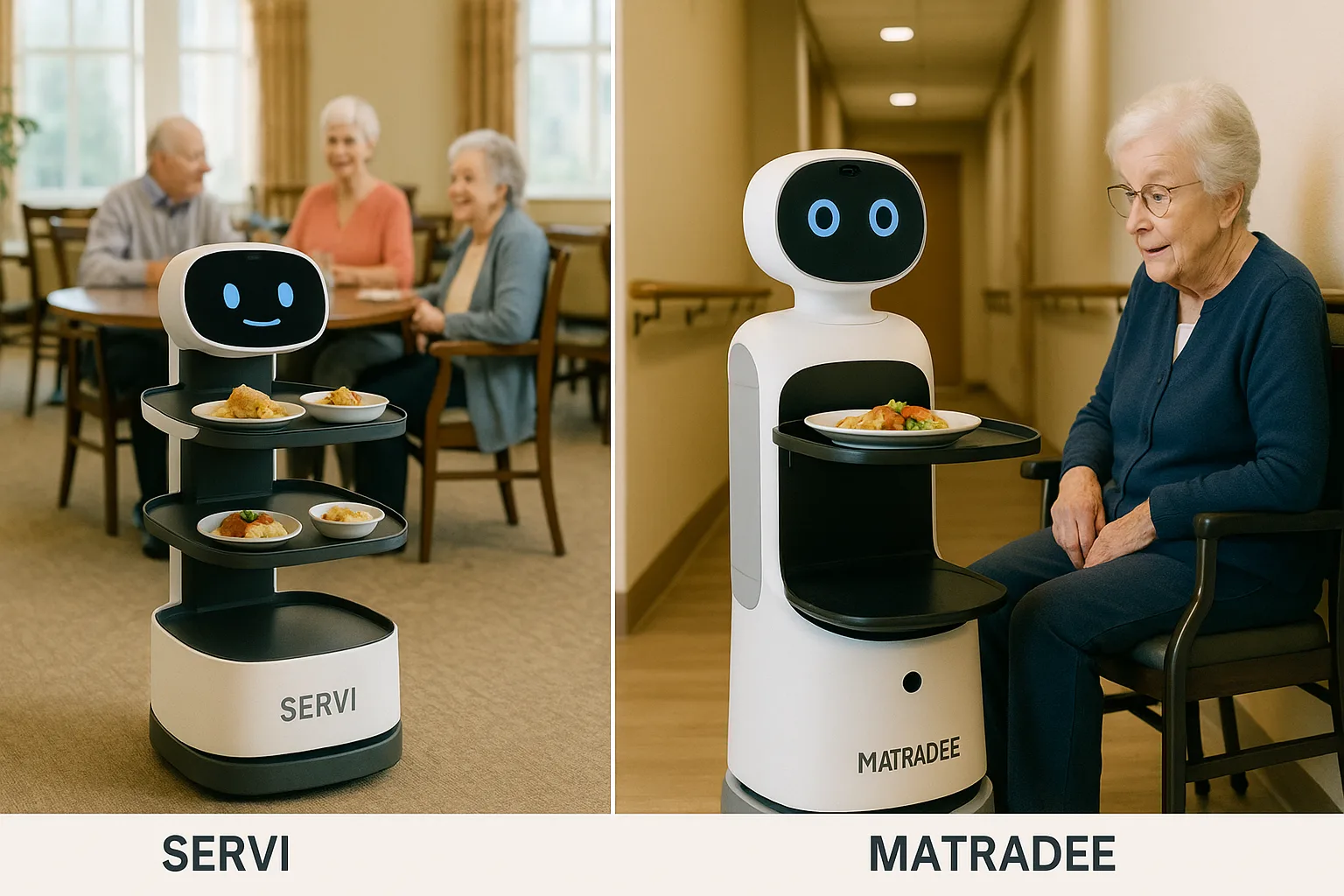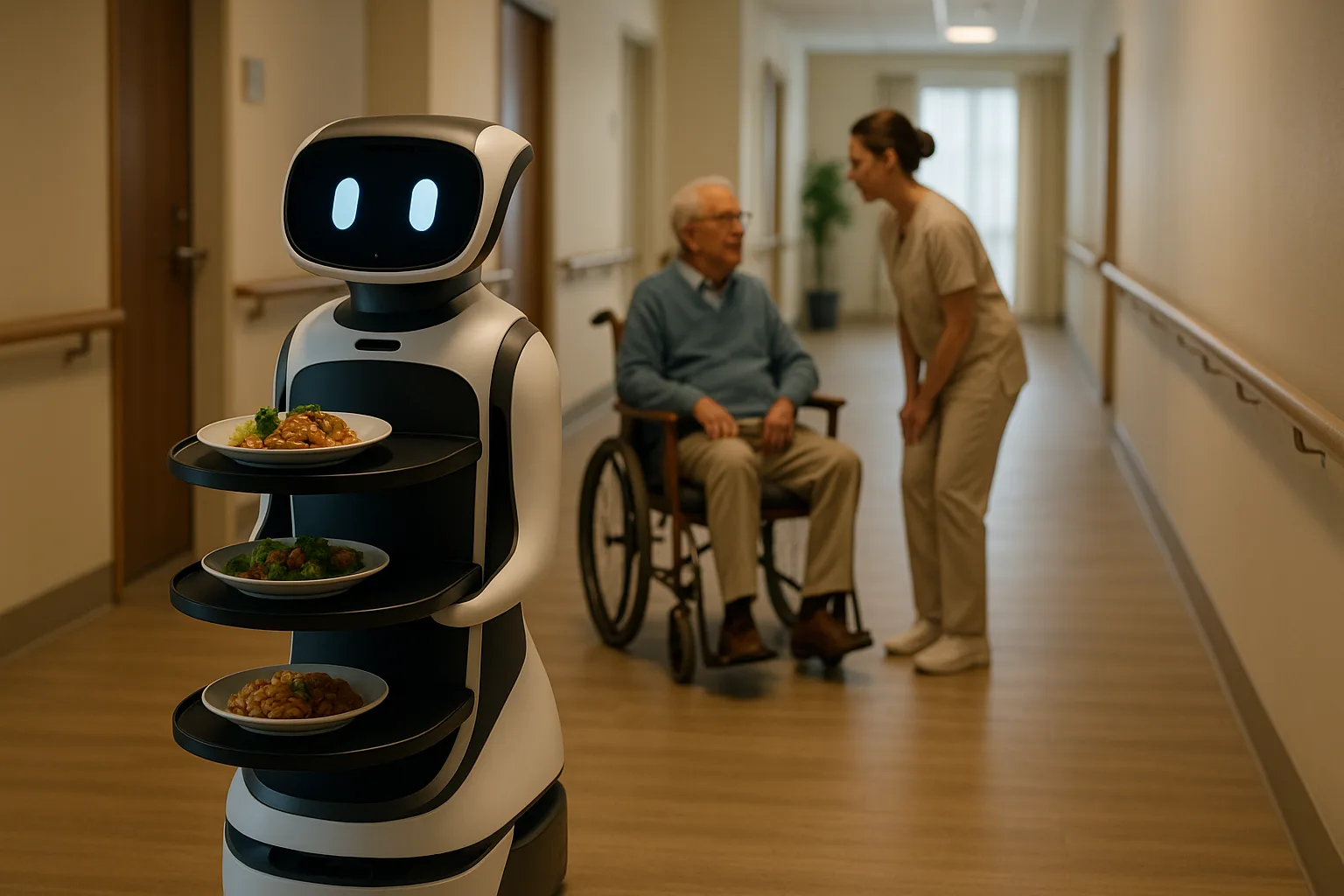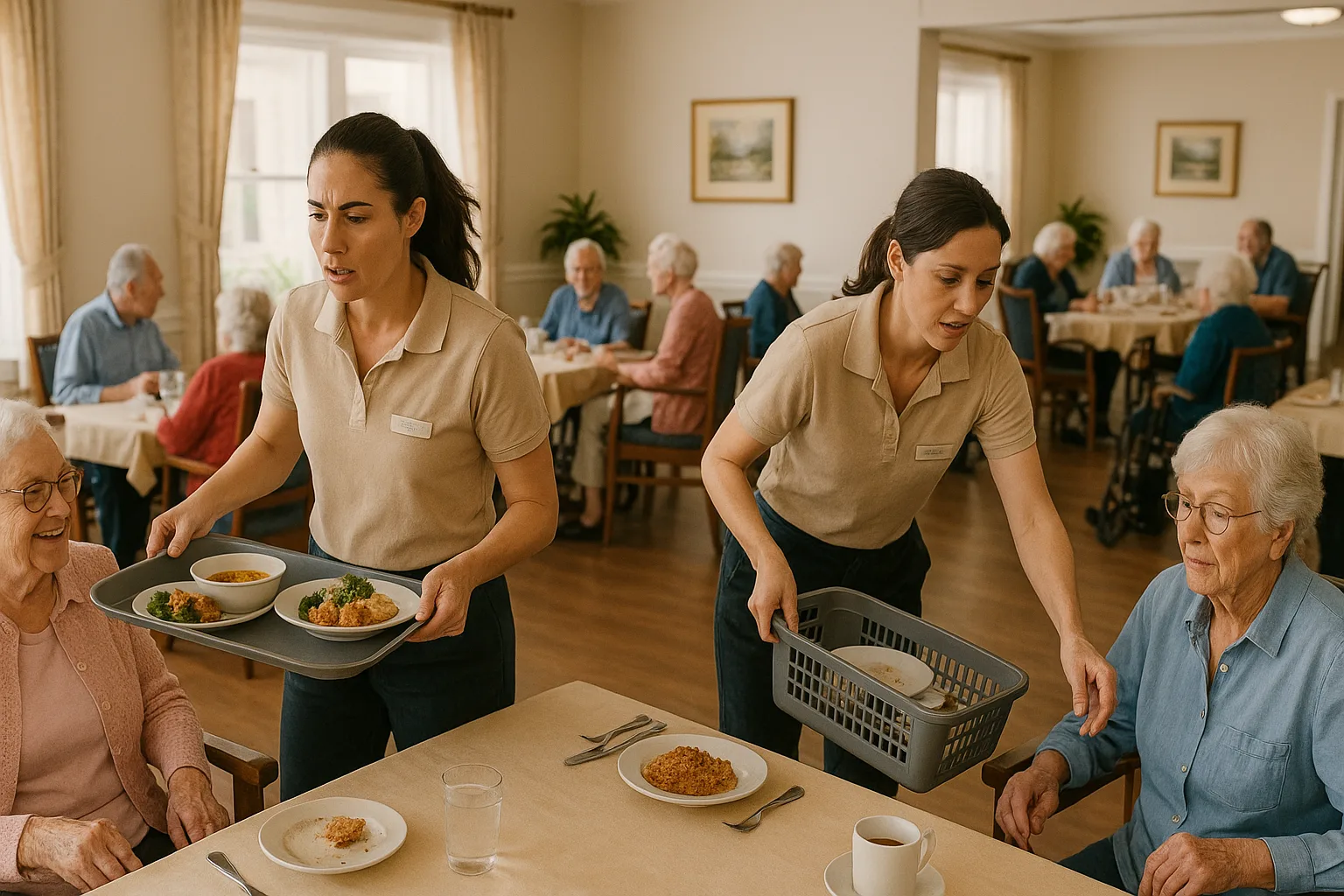🧭 Introduction: Pressure on Dining Teams in Senior Living
If you’ve ever walked through the dining room of a senior living facility during a meal rush, you know it’s a balancing act. Staff are juggling dietary preferences, hot food delivery timing, plate clearing, and—just as importantly—resident interaction. The goal isn’t just efficiency. It’s dignity with consistency.
But with staffing shortages continuing across the senior care sector, it’s getting harder to maintain that balance. Recruiting and retaining dietary aides is tough. Turnover is high. Wages are rising, but so are expectations. Meanwhile, residents still want warm meals delivered promptly—and the human connection that makes a dining room feel like home.
That’s where robotic food servers are starting to earn their place—not by replacing staff, but by relieving pressure. These bots handle the repetitive, time-consuming trips between the kitchen and dining areas, freeing up human team members to focus on what truly matters: care, presence, and attention to detail.
In this article, we’ll explore how senior living facilities are using robotic food servers to:
- Improve operational efficiency
- Reduce manual workload without sacrificing service quality
- And reinvest saved hours into better care outcomes
Spoiler: the numbers are more compelling than you might think.
2. 🏥 The Senior Living Context: Why Efficiency Matters
Dining in senior care isn’t just about nutrition. It’s about timing, trust, and maintaining a sense of dignity for every resident. Meals are scheduled, personalized, and expected to be delivered hot and on time — sometimes across multiple wings, floors, or buildings.
Behind the scenes, this creates a demanding workflow for dietary staff:
- Meals are plated in bulk, but must be delivered in sequence.
- Dietary aides push carts across long hallways, make multiple trips per meal, and often double as dish runners, light cleaners, and point-of-contact staff.
- Service expectations stay high — even when staffing is short.
What happens when someone calls in sick? Or two aides are covering the workload of four?
These aren’t rare scenarios. They’re daily realities. According to a case study by Culinary Services Group, a single robotic food server was able to save one senior care facility up to 92 labor hours per week by handling repetitive food delivery trips — a savings equivalent to two part-time aide roles source.
For a facility that’s already short-staffed, that’s not just a nice-to-have — it’s a game-changer.
And while robots won’t engage with residents the way human staff do, what they can do is reduce the logistical burden enough to let your team breathe — and show up more meaningfully when it matters most.
🤖 Enter the Robot Server – Not a Gimmick, a Team Member
There’s a lot of noise in the robotics space — sleek machines with glowing eyes promising the future of dining. But in senior care, the best robots aren’t the ones that look impressive. They’re the ones that quietly reduce strain on your team without disrupting the flow of service.

Illustrated workflow of human staff delivering meals from kitchen to dining area in a senior living facility, emphasising long walking paths and repetitive tasks
Robotic food servers, like the ones used at The Homestead in partnership with Culinary Services Group, are built for one job: repeatable, reliable delivery. That includes tasks like:
- Transporting plated meals from the kitchen to designated tables
- Returning empty trays to the dish room
- Making back-and-forth trips between meal courses without requiring staff input
They operate autonomously using sensors, pre-mapped floor plans, and safety features like obstacle detection, controlled speed, and voice alerts.
More importantly, they do something else:
They give time back to your staff.
Instead of spending 10–15 minutes per resident roundtrip walking trays, your team can focus on:
- Greeting and seating residents
- Ensuring accuracy for dietary restrictions
- Addressing special requests
- Spending more than 30 seconds at a table
These bots don’t take jobs — they take the pressure off. They’re not replacing the human element; they’re making space for it.
In one reported case, a single robot was able to replace up to two part-time dietary aide shifts per week while improving service consistency and timing source.
And unlike a new hire, they don’t call in sick, they don’t take breaks, and they’re happy to do the same route a hundred times a day — exactly how you told them to.
💰 Breaking Down the Numbers
Let’s get into what really matters for administrators: Does it make financial sense?
The short answer: For many facilities, yes — but only when used correctly.
The longer answer involves looking at what these robots actually replace, and what they don’t.
📊 What the Study Actually Found
According to the CSG case study, the addition of robotic food servers resulted in:
- Up to 13 hours of runtime per day per robot
- That’s 92 labor hours per week of potential productivity
- Roughly equivalent to the work output of two part-time dietary aides
This is based on robots like Servi (by Bear Robotics) and Matradee (by Richtech Robotics), which were used to transport plated meals from kitchen to dining areas and return soiled dishware post-meal.
The time saved didn’t just disappear — it was reallocated:
- Staff spent more time on resident interaction and meal personalization
- Fewer dietary aides were required during peak hours
- Workflow felt less rushed, and staff reported higher satisfaction

One robot serves the main dining room while another delivers food in a care wing, demonstrating efficient zone-based deployment in elder care
💰 But What Did It Cost?
Servi, a leased robot at $900/month, plus deployment and shipping, covered more than double the labor hours of two part-time aides at a third of the cost.
Matradee, purchased outright for $18,000 with only a $300 monthly software fee, delivered similar productivity with an even lower total cost over 3 years.
This isn’t a projected ROI. It’s actual operational savings documented during a pilot program at The Homestead — a senior living community partnering with CSG.
Here’s what CSG revealed about actual costs
📊 The Comparison: Staff vs Robot
| Category | 2 Part-Time Aides | Servi (Bear Robotics) | Matradee (Richtech) |
| Weekly Coverage | 42 hours | 91 hours | 91 hours |
| Year 1 Cost | $33,100 (incl. onboarding, wages, taxes) | $11,700 (startup + lease year 1) | $21,600 (purchase + SaaS) |
| Years 2–3 Cost | $60,200 (2 years total wages) | $21,600 (lease payments only) | $7,200 (SaaS fees only) |
| Total (3 Years) | $93,300 | $33,300 | $28,800 |
| Savings | – | $60,000 | $64,500 |
Source: Culinary Services Group – Robotic Food Servers
✅ Real-World Pros
- No recurring costs: One-time CapEx purchase, not another subscription
- Covers multiple shifts: Breakfast, lunch, and dinner service
- Zero sick days: Robots show up 7 days a week, holidays included
- Staffing flexibility: Less pressure to overhire or bring in agency help
- Improved morale: Staff spent more time with residents, not just running trays
⚠️ Considerations & Constraints
Let’s not overpromise. Robots have limits:
- Not every layout is robot-friendly: Tight corners, carpet, and stairs can interfere
- Initial mapping and training takes time
- Residents may need some acclimatization — especially those with cognitive impairments
- Robots don’t troubleshoot — if someone didn’t get their applesauce, your staff still needs to be there
And perhaps most importantly: if you don’t rethink your staffing plan or workflow, the robot just becomes… a very expensive tray table.
What to Consider Carefully
- Matradee requires upfront capital. If your facility isn’t comfortable with one-time equipment purchases, leasing (like with Servi) may be better.
- Robots don’t troubleshoot. If a resident gets the wrong plate or needs assistance opening a carton, your staff still needs to be there.
- ROI depends on deployment. If your layout, scheduling, or workflow isn’t optimized to use the robot fully (e.g. 3+ meals per day), savings may shrink.
💡 Marcus’s Take
The financial upside is real — but only when paired with operational intention. Don’t just buy the robot. Design around it. Assign roles accordingly. Let the robot do the walking so your people can do the connecting.
The Homestead didn’t just save money — they created a more human mealtime experience by giving their staff more time to be human.
Source: Culinary Services Group – Robotic Food Servers
Deeper Dive into this Real-World Example
One of the clearest illustrations of how robotic food servers can work in senior living comes from The Homestead, a senior living community that partnered with Culinary Services Group (CSG) to run a pilot with two leading robots: Servi (by Bear Robotics) and Matradee (by Richtech Robotics).
Their goal wasn’t to reduce headcount. It was to reduce burnout — and bring some breathing room back into a tight dining workflow.

Servi operates in a bright dining room while Matradee delivers meals in a hallway, showcasing adaptive use of robots in different senior care environments
🏡 Facility Snapshot
- Multi-wing senior living community with centralized kitchen
- Peak service load during breakfast, lunch, and dinner
- Staffing strain during weekends and evening meals
- Long internal walkways between kitchen and dining areas
🤖 Robots Deployed
1. Servi by Bear Robotics
- Tray-based delivery robot with three tiers
- Operates on a lease model ($900/month)
- Comes with mapping, safety sensors, and voice guidance
- Staff press a button to send Servi on a route — returns automatically
2. Matradee by Richtech Robotics
- Purchased outright for ~$18,000 with a $300/month software subscription
- Lighter, more compact, and carpet-friendly
- Can operate across multiple zones
- Hands-free automatic door opening and obstacle navigation
🧩 Why These Robots Were a Good Fit
| Factor | Servi | Matradee |
| Floor Plan | Wide hallways and open dining rooms | Narrower passages and tight turns |
| Staff Tech Familiarity | Easy onboarding — tap-and-go system | Simple UI with app-based controls |
| Resident Sensitivity | Soft voice prompts, low disruption | Sleek form factor, minimal visual noise |
| Meal Service Needs | Multiple plated meals at once | Single-task runs with reliability |
| Budget Flexibility | Low upfront investment (lease) | Lower total cost over 3 years |
Together, they created a hybrid automation solution:
- Servi handled lunch and dinner in the main dining areas
- Matradee supported assisted living wings and smaller meal zones
This split ensured full coverage without overwhelming any single route or pushing the robots past their optimal usage range.
💬 Staff & Resident Feedback
- Staff reported feeling “less rushed” during peak service
- Dietary aides had more time to handle special requests and resident questions
- Robots were accepted quickly by residents — some even gave them names
- No reported incidents or meal errors tied to robot use
One dietary manager summed it up:
“They didn’t replace anyone. They just stopped us from running ourselves ragged.”
🧾 Considerations Before Deployment
Robotic food servers can deliver real value — but only if your environment is ready for them. Before rolling in a sleek tray-carrying assistant, it’s worth slowing down and doing a proper operational audit.

A food delivery robot navigates a calm senior care hallway as a staff member engages with a resident, illustrating efficient and supportive care
Here are the key things to evaluate:
🗺️ 1. Floor Layout & Navigation
- Are your hallways wide enough? Most robots need at least 70–80cm of clearance to navigate comfortably.
- Do you have consistent flooring? Thick carpet, uneven tiles, or thresholds can interrupt pathfinding.
- Any slopes or tight turns? Identify areas where navigation may be difficult — these may need to be manually mapped or avoided entirely.
- Doors or elevators? Some models like Matradee can open doors, but elevator integration typically requires advanced models or custom setup.
🍽️ 2. Service Workflow Compatibility
- How are meals currently delivered? Centralized kitchen-to-dining room? Room-by-room? Tray service?
- Will the robot handle plated meals, beverages, or returns?
- Who will load and dispatch the robot? Make sure you’ve got roles assigned — these aren’t fully autonomous from a service workflow standpoint.
- What happens if the robot gets stuck or ignored? Staff need to be trained not just on how to use the robot, but how to trust it.
👥 3. Staff Onboarding & Culture Shift
- Don’t assume the robot will “just help.”
Aides may feel threatened — or annoyed — if you don’t explain how the robot fits into the team. - Reframe it as a tool for reducing the worst parts of the job, not replacing them.
- Offer simple, visual training, and set expectations clearly: the robot isn’t the magic fix, but it’s one less thing on your plate.
👵 4. Resident Experience
- Introduce the robot gradually. Residents — especially those with dementia — may be startled if the robot appears suddenly.
- Give the robot a name. Put a ribbon on it. Make it part of the environment.
- Make sure there’s always a human nearby for any questions, spills, or accessibility needs.
💡 Bonus Tip: Plan Around Recharge Time
Even though most robots run 10–13 hours a day, they still need to recharge. Most auto-dock, but you’ll want to:
- Build the recharge window into your service schedule
- Use downtime for routine cleaning and inspection
- Keep the dock area clear and accessible
Want a tool to help you assess readiness? We’re working on a downloadable Robot Deployment Checklist for Senior Living — let us know if you’d like early access.
📈 The Long-Term View – Scaling Thoughtfully
Once you’ve piloted a robotic server and seen the early wins — saved time, less rush, better meal pacing — the obvious next question is: “Should we get more?”
Maybe. But not immediately.
Scaling robotic food service isn’t just about ordering another unit. It’s about adapting the system around the robot’s presence, and figuring out what role it’s truly playing in your operation.
🧩 Start Small, but Design for Growth
One robot is enough to prove the value — and show the gaps.
- If your robot’s helping at lunch, could it assist at breakfast with a different workflow?
- Could you map separate zones (e.g. assisted living vs memory care) and redeploy across shifts?
- What manual work still isn’t getting offloaded — and could another robot take that on?
Scaling works best when you’ve already:
- Integrated robot tasks into your staffing model
- Trained staff to be confident and independent with the system
- Used reporting or observation to document actual time saved
🤖 Multi-Robot Fleets (When Ready)
Once you’re running two or more robots, consider:
- Fleet scheduling: Assign each robot to a specific mealtime or location
- Charging management: Stagger recharge cycles to avoid overlap
- Workflow specialization: One robot handles meals, another handles returns or late plates
- Redundancy: If one robot fails or needs service, can another pick up the route?
Vendors like Bear Robotics (Servi) and Richtech (Matradee) offer fleet management features — but they’re only useful if you’ve built the operations to support them.
🏗️ From Tray Runner to Workflow Asset
Robots start out doing one simple task — carrying food from point A to point B. But over time, if you integrate them well, they become something more:
- A way to reduce overtime costs without hiring
- A pressure valve when staffing is tight
- A predictable, quiet, non-intrusive teammate
Used well, they help teams show up where humans are most needed — with residents.
🧾 Final Thoughts – Efficiency Without Sacrificing Care
Robots don’t replace people. They replace the grind.
In senior living, where every resident deserves presence, patience, and dignity, your dietary staff shouldn’t be worn out from running trays. They should be focused on making mealtime personal — not just punctual.
What we’re seeing from pilots like The Homestead, and from operators working with Culinary Services Group, is that robotic food servers don’t take away the human touch — they make room for it. They take on the repetitive back-and-forth so your team can be more available, more engaged, and more responsive.
And the numbers make sense too. When you’re looking at $60,000+ in potential labor savings over three years — with zero sick days, no turnover, and no HR paperwork — the case for trying a robot becomes less of a “maybe” and more of a “why not?”
But it’s not about the machine. It’s about what your staff can do when the pressure lifts.
That’s the real upgrade.
Want to explore your options?
Check out our robot profiles for Servi by Bear Robotics and Matradee by Richtech, or dive into our Robot Buying Guide for Senior Living.
❓ FAQ: Robotic Food Servers in Senior Living
What is a robotic food server?
A robotic food server is an autonomous mobile robot designed to deliver meals and return trays in environments like restaurants, hospitals, and senior living communities. It uses sensors and mapped routes to navigate dining rooms, freeing human staff from repetitive delivery tasks.
How do robotic food servers work in senior living facilities?
In senior care settings, robotic food servers are typically used to transport plated meals from the kitchen to dining areas or resident rooms. They operate using autonomous navigation, avoid obstacles, and return to a charging station when not in use.
How much do robotic food servers cost?
Costs vary by model. According to a real-world case study by Culinary Services Group:
- Servi (leased): ~$900/month, totaling $33,300 over 3 years
- Matradee (purchased): $18,000 upfront + $300/month SaaS, totaling $28,800 over 3 years
Both models delivered over 90 hours/week of service coverage.
Can robots replace human dietary aides in senior care?
No — robotic food servers aren’t designed to replace staff, but to support them. They handle repetitive trips, allowing staff to spend more time engaging with residents and less time pushing carts.
What are the benefits of robotic servers in elder care?
- Reduce physical strain and workload for dietary staff
- Improve meal delivery consistency and speed
- Free staff for more meaningful resident interaction
- Potential savings of $60K+ over 3 years compared to part-time aide wages
What should I consider before adding a robot to my facility?
Key factors include:
- Hallway width and flooring type
- Charging station location
- Staff training and acceptance
- Resident awareness and adjustment
- Integration with existing mealtime workflow
Which robots are used in senior living dining rooms?
Popular models include:
- Servi by Bear Robotics – tray delivery robot with leasing model
- Matradee by Richtech Robotics – purchased model with multi-zone capabilities




